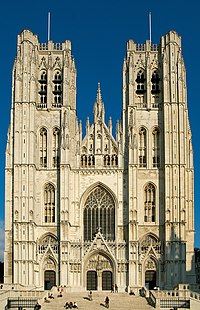| Cathedral of St. Michael and St. Gudula | |
|---|---|
 St. Michael and St. Gudula's Cathedral | |
 | |
| 50°50′52″N 4°21′37″E / 50.84778°N 4.36028°E | |
| Location | Parvis Sainte-Gudule / Sinter-Goedelevoorplein 1000 City of Brussels, Brussels-Capital Region |
| Country | Belgium |
| Denomination | Catholic Church |
| Website | Official website |
| History | |
| Status | Co-cathedral (Cathedral status from 1962) |
| Dedication |
|
| Architecture | |
| Functional status | Active |
| Heritage designation | Protected[1] |
| Designated | 05/03/1936 |
| Architectural type | Cathedral |
| Style | |
| Years built | 11th–15th centuries (church) 1485 (façade and towers) |
| Groundbreaking | c. 9th century (chapel) |
| Completed | 1519 |
| Specifications | |
| Number of towers | 2 |
| Number of spires | 2 |
| Spire height | 64 metres (210 ft) |
| Administration | |
| Archdiocese | |
| Clergy | |
| Archbishop | Luc Terlinden (Primate of Belgium) |
| Dean | Claude Castiau |
| Laity | |
| Organist(s) | Xavier Deprez |
The Cathedral of St. Michael and St. Gudula (French: Cathédrale Saints-Michel-et-Gudule; Dutch: Kathedraal van Sint-Michiel en Sint-Goedele[2]), usually shortened to the Cathedral of St. Gudula[a] or St. Gudula[b] by locals, is a medieval Catholic cathedral in central Brussels, Belgium. It is dedicated to Saint Michael and Saint Gudula, the patron saints of the City of Brussels, and is considered to be one of the finest examples of Brabantine Gothic architecture.
The Romanesque church's construction began in the 11th century, replacing an earlier chapel, and was largely complete in its current Gothic form by the 16th, though its interior was frequently modified in the following centuries. The building includes late-Gothic and Baroque chapels, whilst its neo-Gothic decorative elements, including some of its stained glass windows in the aisles, date from restoration work in the 19th century. St. Gudula also stands out for its musical components, notably its two pipe organs and its immense church bells. The complex was designated a historic monument in 1936.[1]
The church was elevated to cathedral status in 1962 and has since been the co-cathedral of the Metropolitan Archdiocese of Mechelen–Brussels, together with St. Rumbold's Cathedral in Mechelen.[2] As the national church of Belgium and the Primate of Belgium's official seat, it frequently hosts royal weddings, state funerals and other official ceremonies, such as the Te Deum on Belgian National Day.
Since the mid-20th century, following the construction of the North–South connection, St. Gudula has been situated on the Parvis Sainte-Gudule/Sinter-Goedelevoorplein, a large forecourt east of the Boulevard de l'Impératrice/Keizerinlaan. This area is served by Brussels-Central railway station, as well as by Parc/Park metro station on lines 1 and 5 of the Brussels Metro.
- ^ a b Région de Bruxelles-Capitale (2016). "Cathédrale Saints-Michel-et-Gudule" (in French). Brussels. Retrieved 12 May 2019.
- ^ a b Cathedral of St. Michael and St. Gudula on GCatholic.org
- ^ "Cathedrale Saints Michel et Gudule". visit.brussels. Retrieved 14 May 2022.
Cite error: There are <ref group=lower-alpha> tags or {{efn}} templates on this page, but the references will not show without a {{reflist|group=lower-alpha}} template or {{notelist}} template (see the help page).